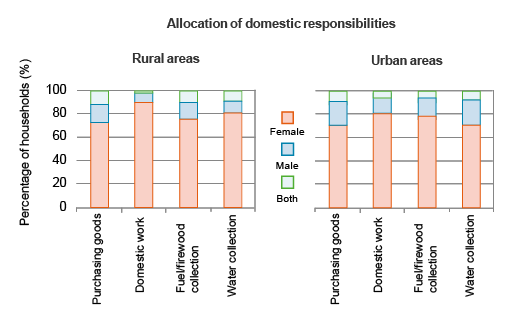3.2 Gender and WASH
Part of women’s triple role is having responsibility for domestic tasks and care of the home. Figure 3.2 shows how unequal the allocation of tasks is between men and women.
Look at Figure 3.2. What is the proportion of households where women have sole responsibility for water collection?
Women have sole responsibility for water collection in about 80% of rural households and about 70% of urban households.
Water collection is one of the most time consuming of these domestic tasks. Many women and girls, especially in rural areas, spend hours each day collecting water for the family. This not only prevents them from doing other more productive work or attending school but can also cause physical damage because of the heavy weight of a full jerrycan. There are other disadvantages. Women, especially in rural communities, spend so much time on domestic chores including fetching water that they have no time to get involved in public decision-making processes, so even if social and cultural attitudes that discourage or prevent their participation could be changed, they have no time to take part.
There is also a gender divide when it comes to sanitation. If latrines are inadequate or non-existent, this has a much greater impact on women than men. Women and girls may wait until dark to relieve themselves, which can be dangerous and make them vulnerable to attack. They may also avoid eating and drinking during the day which can damage their health.
Sanitation also affects school attendance. The lack of separate toilet blocks for girls and boys in schools is widely believed to contribute to poor attendance by girls and makes them more likely to drop out of school entirely. Guidelines recommend girls’ and boys’ blocks with at least 20m between them, and with lockable doors facing in opposite directions (MoE, 2017b). They also require proper facilities for menstrual hygiene management. During their menstrual period, girls and women need access to safe and affordable menstrual absorbents and private facilities for the disposal and/or washing of materials used to absorb menstrual blood, and access to facilities for washing themselves. Despite the guidelines, these requirements are frequently overlooked in the design and construction of school latrine blocks and are also neglected in shared public facilities. Remember facilities also need to be accessible for women and girls with disabilities.
One of the main reasons for the neglect of women’s needs is their exclusion from discussions about the planning and design of WASH services. You will remember from Study Session 1 that this was part of the definition of exclusion. Usually it is men who make decisions about the allocation of finances and they may not prioritise issues that affect women’s lives but not their own. Women are often excluded from participation in decisions about water supply, sanitation and hygiene, even though they are the ones whose lives are most affected. Social attitudes also affect the way in which WASH professionals address issues like menstruation or fistula which have a lot of stigma in many communities. This has a big impact on women and girls.
3.1 Gender roles and equality

